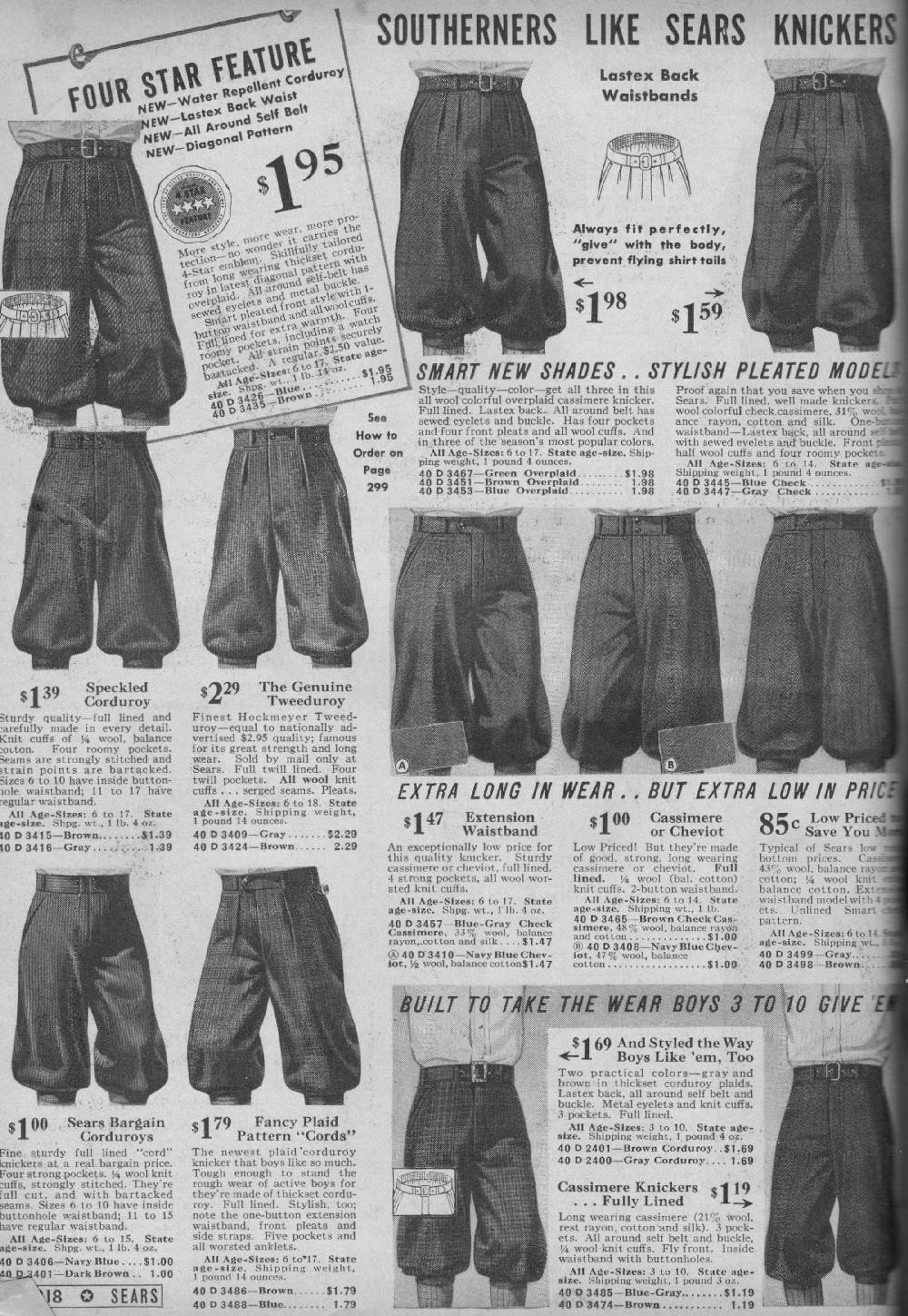
American Mail Order Catalogs with Boys Clothings: Sears Fall-Winter 1939-40 Catalog--Southern Knickers

Figure 1.--The caption for this Winter 1939-40 page was 'Southerners Like Sears Knickers'. Presumably this shows that there were regional differences in the Sears mailings. There were quite a few choices for the knickers. They all had various age ranges. Some were just for boys up to 10 years, but some were available for teenagers up to 17 years of age meaning high schoolers. We see no evience of boys that age wearing knickers in the photograpjic record in 1939. Although there were many knickers to chose from, they all look rather much the same with the elasticize knit leg closing rather thn the buckle closures common in the 1920s. The only basic differece ee see are the self-belts some of the knickers have as well as latex backs and regular waists. Other than that the basic difference seems to be the material. Sears Four Star beand featurs water repellant corduroy, latex back waists, all around self belt, and diagonal patterns. Many of the offerings have latex back waitbands which Sears says, "Always fit perfevtly, 'give' with the bid, prevent flying shirt tails. At the time, boys were expected to tuck in their shirt tails. We see blue, brown, green, and grey, many done in patterens. We see cassimere, cheviot, corduroy, mixed blends, and something Sears calls Tweeduroy.
|
|
The caption for this Winter 1939-40 page was 'Southerners Like Sears Knickers'. Presumably this shows that there were regional differences in the Sears mailings. There were quite a few choices for the knickers. They all had various age ranges. Some were just for boys up to 10 years, but some were available for teenagers up to 17 years of age meaning high schoolers. We see no evience of boys that age wearing knickers in the photograpjic record in 1939. Although there were many knickers to chose from, they all look rather much the same with the elasticize knit leg closing rather thn the buckle closures common in the 1920s. The only basic differece ee see are the self-belts some of the knickers have as well as latex backs and regular waists. Other than that the basic difference seems to be the material. Sears Four Star beand featurs water repellant corduroy, latex back waists, all around self belt, and diagonal patterns. Many of the offerings have latex back waitbands which Sears says, "Always fit perfevtly, 'give' with the bid, prevent flying shirt tails. At the time, boys were expected to tuck in their shirt tails. We see blue, brown, green, and grey, many done in patterens. We see cassimere, cheviot, corduroy, mixed blends, and something Sears calls Tweeduroy.
The Sears, Roebuck and Co., huge merchandising firm centered in Chicago was founded by Richard W. Sears (1863-1914) and A.C. Roebuck (1864-1948).
Sears had begun a career in mail-order business in Minnesota 1886. In Chicago he and Roebuck joined resources and formed a corporation in 1893 as a
mail-order business under title Sears, Roebuck and Company. In 1895 Julius Rosenwald (1862-1932) bought Roebuck's interest in firm and became president on
Sears's retirement 1908. A retail-store system was added 1925. The first foreign store added in Havana, Cuba during 1945 and becane te first expropriated store in 1960. The Sears-Roebuck brought the production of industry to the fartherest corner of rural America, opening the cornucopia of the consumer age to rural America. All the new things that were changing American life danced across their pages. Through it, a huge Chicago warehouse offers to modernize the farms and small towns of the Midwest.
Knickers Page
The caption for this Winter 1939-40 page was 'Southerners Like Sears Knickers'. Presumably this shows that there were regional differences in the Sears mailings. There were quite a few choices for the knickers. They all had various age ranges. Some were just for boys up to 10 years, but some were available for teenagers up to 17 years of age meaning high schoolers. We see no evience of boys that age wearing knickers in the photograpjic record in 1939. Although there were many knickers to chose from, they all look rather much the sane wiyh the elasticize knit leg closing rather thn the buckle closures vommn in the 1920s. The only basic differece e see are the self-belts some of the knickers have as well as latex backs and refular waists. Other than that the basic difference seems to be the material. Sears Four Star beand featurs water repellant corduroy, latex back waists, all around self belt, and diagonal patterns. Many of the offerings have latex back waitbands which Sears says, "Always fit perfevtly, 'give' with the bid, prevent flying shirt tails. At the time, boys were expected to tuck in their shirt tails. We see blue, brown, green, and grey, many done in patterens. We see cassimere, cheviot, corduroy, mixed blends, and something Sears calls Tweeduroy.
HBC

Navigate the Boys' Historical Clothing catalog/magazine pages:
[Return to the Main American mail order 1939 page]
[Main photo/publishing page]
[Store catalogs]
[Fashion magazines]
Navigate the Boys' Historical Clothing Web Site:
[About Us]
[Introduction]
[Activities]
[Biographies]
[Chronology]
[Cloth and textiles]
[Clothing styles]
[Countries]
[Topics]
[Bibliographies]
[Contributions]
[FAQs]
[Glossaries]
[Images]
[Links]
[Registration]
[Tools]
Navigate the Boys' Historical Clothing Web Site:
[Sailor suits]
[Sailor hats]
[Buster Brown suits]
[Eton suits]
[Rompers]
[Tunics]
[Smocks]
[Long stockings]
Created: 8:44 PM 10/2/2017
Last updated: 8:44 PM 10/2/2017



